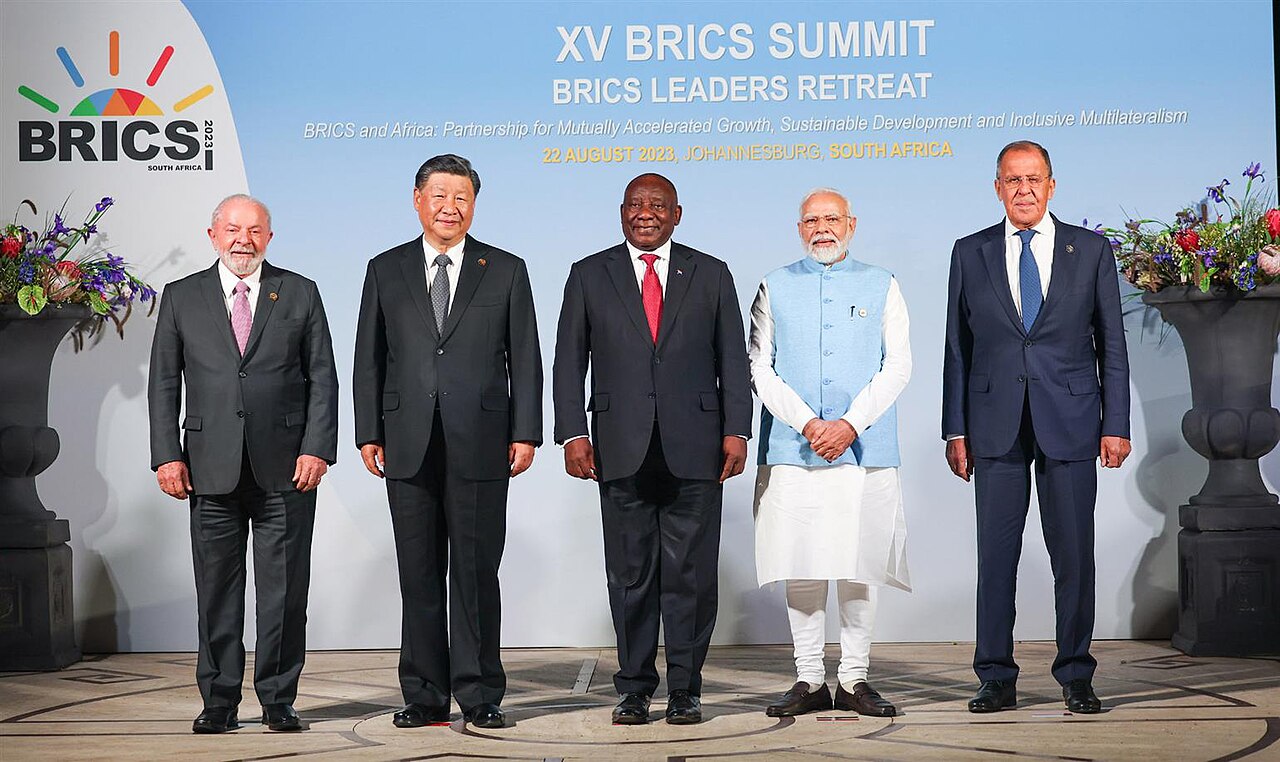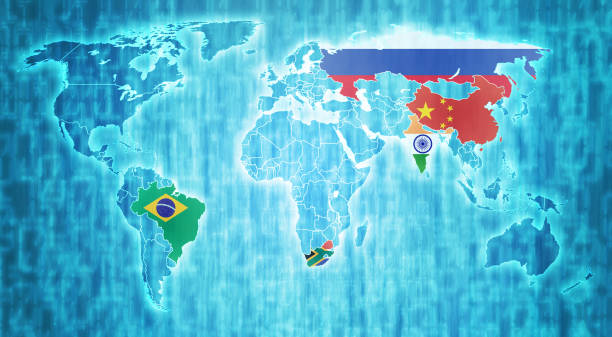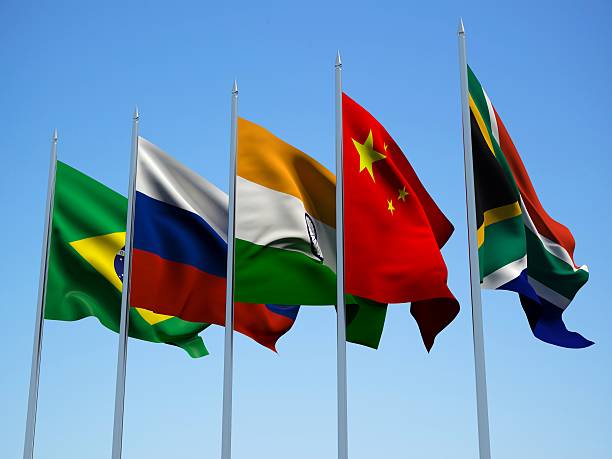The BRICS nations, comprising Brazil, Russia, India, China, and South Africa, are steadily moving towards establishing a new reserve currency that could profoundly impact the global financial landscape. What once seemed like a temporary alliance is now evolving into a significant geopolitical force, capable of challenging the long-standing dominance of the U.S. dollar in international trade and finance.
This shift comes at a time when global economic conditions, coupled with U.S. foreign policies, have driven BRICS members to seek financial independence. While there is no official timeline for the release of a BRICS currency, the very discussion of such an idea is causing concern in Washington, as the potential for de-dollarization grows.
Why BRICS Wants a New Currency
The rationale behind the push for a BRICS currency is multifaceted. For decades, the U.S. dollar has been the backbone of global trade, dominating about 90% of currency trading. Until recently, almost all oil transactions were conducted in U.S. dollars. However, 2023 marked a shift, with approximately one-fifth of global oil trades being conducted in non-dollar currencies, signaling an increasing willingness to bypass the greenback.
For BRICS nations, establishing a currency independent of the dollar and euro could allow them to serve their economic interests more effectively, particularly in light of aggressive U.S. sanctions on countries like Russia and Iran. China and Russia have been particularly active in promoting de-dollarization, seeking to diminish the U.S.’s ability to use its currency as a tool of geopolitical influence.
The Growing Momentum Behind a BRICS Currency
Speculation around the introduction of a BRICS currency has gained traction over the last two years. During the 14th BRICS Summit in 2022, Russian President Vladimir Putin suggested the bloc was preparing to launch a new global reserve currency. This was echoed by Brazil’s President Luiz Inácio Lula da Silva in 2023, who openly questioned the dominance of the U.S. dollar, advocating for a BRICS-backed currency to facilitate trade between member nations.
The possibility of a BRICS currency was further fueled by the expansion of the group. In August 2023, six new countries—Argentina, Egypt, Ethiopia, Iran, Saudi Arabia, and the United Arab Emirates—were invited to join BRICS, increasing the economic clout of the bloc. While the official launch of a BRICS currency is not yet on the horizon, the increasing cooperation and coordination among these nations indicate that it is more than just theoretical.
 BRICS leaders at 15th BRICS SUMMIT
BRICS leaders at 15th BRICS SUMMIT
The U.S. Response: Concern Over De-dollarization
The prospect of a BRICS currency has not gone unnoticed by the U.S. government. Former President Donald Trump, during a presidential debate in 2023, reiterated his stance on imposing heavy tariffs on nations that attempt to reduce their reliance on the U.S. dollar. The U.S.-China trade war, sanctions on Russia, and broader efforts to maintain the dollar’s hegemony reflect Washington’s awareness of the growing challenge posed by BRICS.
While the U.S. dollar remains the dominant reserve currency, used in 88% of currency exchanges globally, the possibility of a competing currency from a bloc as large as BRICS could undermine the dollar’s status. If the BRICS currency were to be widely adopted for trade between member countries, it would reduce demand for the dollar, weakening its role as the world’s reserve currency. This could lead to a cascading effect where more countries shift away from the dollar, diminishing its value and influence in the global economy.
Challenges to a BRICS Currency
Despite the enthusiasm within BRICS, the creation of a new currency is not without significant challenges. One major concern is the economic disparity between member nations, particularly between China, the world’s second-largest economy, and other BRICS nations. There is also the risk that smaller economies in the bloc could become overly dependent on China’s yuan, thereby undermining their own financial independence.
Moreover, the logistics of creating a reserve currency that is backed by a basket of national currencies, rather than pegged to a single commodity like gold, could prove difficult. As Jim Rickards, a financial expert, has pointed out, while a gold-backed BRICS currency could theoretically work, it would require extensive preparation and coordination, much like the creation of the euro.
Another potential roadblock is the differing political and economic interests within the BRICS bloc. For instance, when Russia demanded in 2023 that India pay for oil in yuan, India refused, insisting on using either U.S. dollars or Indian rupees. Such disagreements underscore the challenges BRICS may face in creating a truly unified currency.
The Technological Dimension: BRICS Digital Currency and Blockchain
In addition to a traditional currency, BRICS nations are exploring the development of a blockchain-based payment system. Kremlin aide Yury Ushakov announced in early 2024 that BRICS is working on the BRICS Bridge multisided payment platform, which would connect member states’ financial systems via central bank digital currencies (CBDCs). This payment platform would bypass existing global financial systems, such as the U.S.-dominated Society for Worldwide Interbank Financial Telecommunication (SWIFT), offering a more efficient, politically neutral alternative.
By leveraging blockchain technology, a BRICS digital currency could offer more transparent, secure, and faster cross-border payments. This could revolutionize the way BRICS members conduct trade, reducing their reliance on U.S.-controlled financial systems and providing more autonomy.
Potential Impact on the U.S. Dollar
If a BRICS currency were to materialize, it would undoubtedly challenge the dollar’s dominance in international trade. Currently, around 59% of global foreign currency reserves are held in U.S. dollars. A BRICS currency could shift this balance, encouraging central banks to diversify their holdings. De-dollarization could also weaken the effectiveness of U.S. sanctions, as nations would no longer be as reliant on dollar-based transactions.
Additionally, a decrease in global demand for U.S. dollars could lead to inflationary pressures domestically, as the dollar’s value could drop in response to reduced demand. This, in turn, could have broader economic implications, affecting everything from American household incomes to international investment in U.S. markets.
How Investors Can Prepare
For investors, the emergence of a BRICS currency presents both risks and opportunities. Diversification will be key in navigating these changes. Investors may consider shifting part of their portfolios into assets denominated in other currencies, such as bonds or equities in BRICS nations. Additionally, commodities like gold and silver, which often rise in value when fiat currencies weaken, could serve as a hedge against potential currency fluctuations.
Investing in BRICS-focused exchange-traded funds (ETFs) or stocks from companies in these nations could also offer exposure to the economic growth within the bloc. However, investors should remain cautious, as geopolitical volatility and currency fluctuations could present significant risks.
How Would a BRICS Currency Impact the Global Economy?
The introduction of a BRICS currency could bring sweeping changes to the global economy, particularly affecting regions that are heavily reliant on the US dollar, such as North America. Various sectors would likely experience significant impacts, and investors would need to adapt to a new economic landscape.
*Key Sectors Affected:
1. Oil and Gas: A BRICS currency could alter the way global energy is traded. Historically, oil has been traded almost exclusively in US dollars, but a BRICS currency could diversify this, impacting energy prices and trade dynamics. Nations in the BRICS bloc may prefer to conduct oil transactions in their new currency, reducing dependence on the dollar.
2. Banking and Finance: The financial sector could see a shift as international transactions, traditionally dominated by the US dollar, might increasingly be settled in the new BRICS currency. This would affect banks’ foreign reserves and global capital flows.
3. Commodities: Commodities like gold, silver, and agricultural products could see new pricing mechanisms, and commodity-exporting nations within BRICS may push for more favorable terms of trade in their own currency, challenging the US dollar’s stronghold in global commodity markets.
4. International Trade: The introduction of a BRICS currency could realign global trade patterns. Countries that wish to reduce reliance on the US dollar or avoid American sanctions may turn to the BRICS bloc, expanding trade relationships within this alternative economic system.
5. Technology: With digital payment systems and blockchain technology likely playing a central role in the BRICS currency framework, the technology sector could experience heightened demand for innovations supporting cross-border transactions and digital currencies.
6. Tourism and Travel: For tourism, the use of a BRICS currency in several key destinations, such as China, Brazil, and South Africa, could influence currency exchange rates and spending patterns for travelers from non-BRICS countries.
7. Foreign Exchange Market: The forex market would need to adapt to the addition of a new major currency. New trading pairs, currency correlations, and increased volatility could result as traders and investors adjust to the economic realities of a BRICS reserve currency.
In essence, the introduction of a BRICS currency would force major adjustments across the global economy, with ripple effects on trade, finance, and international relations.
FAQs About a Possible BRICS Currency
 BRICS Nation in World Map
BRICS Nation in World Map
As discussions surrounding the creation of a BRICS currency gain momentum, many questions arise about its feasibility, structure, and global impact. Below are some of the most commonly asked questions regarding the BRICS currency.
Is a BRICS Currency Possible?
Some experts believe that the creation of a BRICS currency could be possible, drawing comparisons to the creation of the euro in 1999. However, the process would be complex and require years of planning and negotiation. The BRICS countries would need to establish a central bank for the new currency, agree on phasing out their individual national currencies for this bloc-wide currency, and gain the support of global financial institutions like the International Monetary Fund (IMF).
There are significant challenges to this, however. The war in Ukraine has weakened Russia’s economy, which could complicate its role in the new currency framework. Furthermore, China’s ambition to elevate the yuan on the global stage could create friction, as its economy vastly outweighs the others in the BRICS bloc, making it difficult to balance interests among the nations.
Would the BRICS Currency Be Backed by Gold?
There has been speculation about whether the BRICS currency might be backed by gold, with Russian President Vladimir Putin hinting at this possibility. The idea is that backing the currency with tangible assets like gold or oil could provide stability and make the currency a serious contender on the global stage.
In a 2023 conference, author and economist Jim Rickards proposed a model where a BRICS currency would be valued based on gold. For example, if one unit of the BRICS currency were pegged to the value of one ounce of gold, and gold reached $3,000 per ounce, the BRICS currency unit would also be worth $3,000. This would allow the BRICS currency to appreciate relative to the US dollar, potentially destabilizing the dollar’s dominance.
However, it’s important to note that even if the BRICS currency is tied to gold, this would not necessarily represent a return to the gold standard. Instead, it could be a mechanism to stabilize the currency and promote trust among global investors.
How Much Gold Do BRICS Nations Have?

As of the second quarter of 2024, the BRICS nations collectively hold substantial reserves of gold. Brazil, Russia, India, China, and South Africa, along with new member Egypt, possess more than 20% of the total gold held in the world’s central banks. Russia holds around 2,335.85 metric tons (MT) of gold, making it the fifth-largest holder globally. China follows closely with 2,264.32 MT, while India ranks eighth with 840.76 MT.
Brazil and South Africa have relatively smaller gold reserves, with 129.65 MT and 125.44 MT, respectively. Egypt, one of the newest members of the BRICS bloc, has 126.57 MT of gold in its central bank reserves.
This significant reserve of gold across BRICS countries would bolster their ability to back a new currency with hard assets, although they do not necessarily need to own gold outright to benefit from rising gold prices.
What’s the Future Outlook for the BRICS Currency?
The potential for a BRICS currency to challenge the US dollar’s dominance depends on several factors, including its adoption, the strength of the currency’s underlying economy, and global geopolitical developments. Some analysts predict that a new BRICS currency could accelerate the trend of de-dollarization, as more countries seek alternatives to the dollar in international trade.
Nevertheless, while the BRICS currency has the potential to alter the global economic landscape, the US dollar is still deeply entrenched in global financial systems. Recent studies show that the dollar continues to dominate foreign reserve holdings and international trade invoicing, making it unlikely to be unseated in the short term.
Conclusion
The possibility of a BRICS currency is no longer a distant prospect but a growing reality that could reshape the global financial order. While the U.S. dollar remains dominant, the steady push towards de-dollarization among BRICS nations highlights the changing dynamics of international trade and finance. The introduction of a new BRICS currency could accelerate this trend, reducing U.S. influence and offering emerging economies greater autonomy. However, the road to establishing such a currency will not be without its challenges, and the full impact on the global economy remains to be seen.

